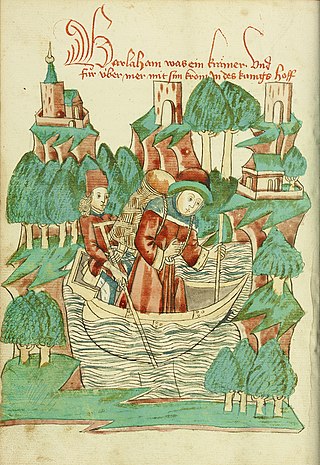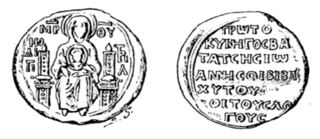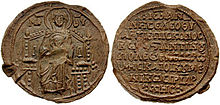
John V Palaiologos or Palaeologus was Byzantine emperor from 1341 to 1391, with interruptions. His long reign was marked by constant civil war, the spread of the Black Death and several military defeats to the Ottoman Turks, who rose as the dominant power of the region.

John VI Kantakouzenos or Cantacuzene was a Byzantine Greek nobleman, statesman, and general. He served as grand domestic under Andronikos III Palaiologos and regent for John V Palaiologos before reigning as Byzantine emperor in his own right from 1347 to 1354. Deposed by his former ward, he was forced to retire to a monastery under the name Joasaph Christodoulos and spent the remainder of his life as a monk and historian. At age 90 or 91 at his death, he was the longest-lived of the Roman emperors.

Gregory Palamas was a Byzantine Greek theologian and Eastern Orthodox cleric of the late Byzantine period. A monk of Mount Athos and later archbishop of Thessalonica, he is famous for his defense of hesychast spirituality, the uncreated character of the light of the Transfiguration, and the distinction between God's essence and energies. His teaching unfolded over the course of three major controversies, (1) with the Italo-Greek Barlaam between 1336 and 1341, (2) with the monk Gregory Akindynos between 1341 and 1347, and (3) with the philosopher Gregoras, from 1348 to 1355. His theological contributions are sometimes referred to as Palamism, and his followers as Palamites.
This is an alphabetical index of people, places, things, and concepts related to or originating from the Byzantine Empire. Feel free to add more, and create missing pages. You can track changes to the articles included in this list from here.

Barlaam of Seminara, c. 1290–1348, or Barlaam of Calabria was a Basilian monk, theologian and humanistic scholar born in southern Italy. He was a scholar and clergyman of the 14th century, as well as a humanist, philologist and theologian.

Fifth Council of Constantinople is a name given to a series of seven councils held in the Byzantine capital Constantinople between 1341 and 1368, to deal with a dispute concerning the mystical doctrine of Hesychasm. These are referred to also as the Hesychast councils or the Palamite councils, since they discussed the theology of Gregory Palamas, whom Barlaam of Seminara opposed in the first of the series, and others in the succeeding six councils.
The House of Kantakouzenos, also found in English-language literature as Cantacuzenus or Cantacuzene, was a Byzantine Greek noble family that rose to prominence in the middle and late Byzantine Empire. The family became one of the empire's wealthiest landowners and provided several prominent governors and generals, as well as two Byzantine emperors between 1347–1357.
The Zealots were a political group that dominated political developments in Thessalonica from 1342 until 1350. The contemporary sources, notably anti-Zealot in sympathies, provide little information on the Zealots' government of Thessalonica. The Zealots managed to establish effective civic self-government for eight years. They confiscated the property of the aristocracy, and redistributed their wealth. In the past it had been claimed that the Zealots had a kind of social reform program, but sources are scant. Many of these claims were built upon a discourse of the scholar Nikolaos Kabasilas, but eventually it seems that it had no connection to the Zealot revolt but was composed many decades later.
Philotheos Kokkinos was the Ecumenical Patriarch of Constantinople for two periods from November 1353 to 1354 and 1364 to 1376, and a leader of the Byzantine monastic and religious revival in the 14th century. His numerous theological, liturgical, and canonical works received wide circulation not only in Byzantium but throughout the Slavic Orthodox world.
Gregory Akindynos was a Byzantine theologian of Bulgarian origin. A native of Prilep, he moved from Pelagonia to Thessaloniki and studied under Thomas Magistros and Gregory Bryennios. He became an admirer of Nikephoros Gregoras after he was shown an astronomical treatise of that scholar by his friend Balsamon in 1332, writing him a letter in which he calls him a "sea of wisdom". From Thessaloniki, he intended to move on to Mount Athos, but for reasons unknown, he was refused.

Palamism or the Palamite theology comprises the teachings of Gregory Palamas, whose writings defended the Eastern Orthodox practice of Hesychasm against the attack of Barlaam. Followers of Palamas are sometimes referred to as Palamites.

Anna of Savoy, born Giovanna (1306–1365), was a Byzantine Empress consort, as the second spouse of Andronikos III Palaiologos. She served as regent, with the titles augusta and autokratorissa, during the minority of her son John V Palaiologos from 1341 until 1347. In Byzantium, she was known as Anna Palaiologina, owing to her marriage to Andronikos.
Irene Asanina, was the empress consort of John VI Kantakouzenos of the Byzantine Empire. She is known to have participated in military issues in a degree uncommon for a Byzantine empress. She commanded the garrison of Didymoteicho during the Byzantine civil war of 1341–1347, and organized the defense of Constantinople against the Genoese in 1348, and the forces of John V in 1353.
Isidore I was the Ecumenical Patriarch of Constantinople from 1347 to 1350. Isidore Buchiras was a disciple of Gregory Palamas.

Alexios Apokaukos, also Latinized as Alexius Apocaucus, was a chief minister and head of the navy in the Byzantine Empire, during the reigns of emperors Andronikos III Palaiologos and John V Palaiologos. Although he owed his rise to high state offices to the patronage of John VI Kantakouzenos, he became, together with Patriarch John XIV Kalekas, one of the leaders of the faction supporting Emperor John V in the civil war of 1341–1347 against his one-time benefactor. Apokaukos died when he was lynched by political prisoners during an inspection of a new prison.
The Byzantine civil war of 1341–1347, sometimes referred to as the Second Palaiologan Civil War, was a conflict that broke out in the Byzantine Empire after the death of Andronikos III Palaiologos over the guardianship of his nine-year-old son and heir, John V Palaiologos. It pitted on the one hand Andronikos III's chief minister, John VI Kantakouzenos, and on the other a regency headed by the Empress-Dowager Anna of Savoy, the Patriarch of Constantinople John XIV Kalekas, and the megas doux Alexios Apokaukos. The war polarized Byzantine society along class lines, with the aristocracy backing Kantakouzenos and the lower and middle classes supporting the regency. To a lesser extent, the conflict acquired religious overtones; Byzantium was embroiled in the Hesychast controversy, and adherence to the mystical doctrine of Hesychasm was often equated with support for Kantakouzenos.

The Hesychast controversy was a theological dispute in the Byzantine Empire during the 14th century between supporters and opponents of Gregory Palamas. While not a primary driver of the Byzantine Civil War, it influenced and was influenced by the political forces in play during that war. The dispute concluded with the victory of the Palamists and the inclusion of Palamite doctrine as part of the dogma of the Eastern Orthodox Church as well as the canonization of Palamas.

John Vatatzes or Batatzes was a Byzantine official and magnate active in the second quarter of the 14th century, playing a prominent role in the Byzantine civil war of 1341–1347.

Theodore Komnenos Doukas Palaiologos Synadenos, usually simply Theodore Synadenos, was a Byzantine magnate, senior official and military leader of the early 14th century, who played an important role in the civil wars of the period. The scion of a noble lineage, he became one of the first and most prominent supporters of Andronikos III Palaiologos in his struggle against his grandfather Andronikos II. Synadenos held various provincial governorships during Andronikos III's reign, including Epirus and Thessalonica. After the outbreak of the civil war of 1341–1347, he tried to surrender Thessalonica to his old friend John Kantakouzenos, but was driven from the city by the Zealots of Thessalonica. Forced to join Kantakouzenos's enemies, he was initially honoured with the high rank of protovestiarios but soon placed under house arrest in Constantinople, where he died impoverished in 1345 or 1346.
Andronikos Palaiologos was a Byzantine aristocrat and military commander during the Byzantine civil war of 1341–47.









